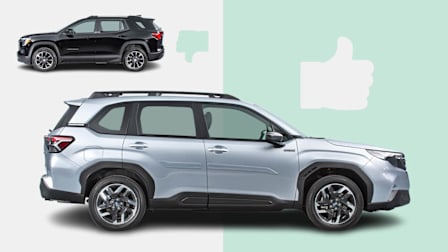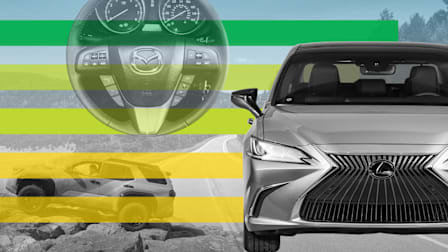Why Choosing the Right Car Matters More Than Ever
Our experts share their dos and don’ts for navigating car buying in the age of tariffs, tax incentives, and price volatility

High transaction prices, changing tax credits, and uncertainty around tariffs might have you worried about your next car purchase. That’s why it’s more important than ever to choose a car that will be worth every penny you spend, and that will serve your needs for years to come.
- Do: Buy a Safe, Reliable, Satisfying Car Check Transaction Prices See What Tax Incentives Apply Have a Backup Plan Buy a Car That Will Get to 200,000 Miles Consider Maintenance and Repair Costs
- Don't: Buy a Car If You Can Fix the One You Already Own Buy a Discounted Model Rush at the Dealership
- CR's Build & Buy Car Buying Service
Do: Buy a Safe, Reliable, Satisfying Car
Every year, Consumer Reports asks hundreds of thousands of vehicle owners what issues they had with their cars, and whether they still like the vehicle they drive. We also analyze crash test data and account for how much proven safety technology comes standard. We also test nearly every vehicle on the market. Put together, these results create each vehicle’s Overall Score, a number out of 100 that quickly tells you how that car ranks. This data, available to CR members, tells you which vehicles are the most trouble-free and which vehicles keep drivers happy. Our Top Picks highlight the best vehicles in every major category, but we also put together specific lists of the top-rated SUVs, most fuel-efficient vehicles, and most satisfying new cars. “If you plan to keep a car for the long term, think about factors like cargo space and fuel economy, and whether it will meet your needs now and in the future,” says Fisher.
Do: Check Transaction Prices
Some automakers say they’re locking in prices for a fixed period of time. Others are saying they’ll make “market adjustments” to raise prices above the manufacturer’s suggested retail price (MSRP). How can you be sure you’re getting a good deal? Check prices on the “View Pricing Information” tab of CR’s car model pages, available through the A-Z ratings tool, and use CR’s Build & Buy program. It uses data from TrueCar, a Consumer Reports partner, to track real transaction prices from over 12,000 dealerships across the country. Using this, you can see what other buyers in your area have paid for similar vehicles, and what prices are considered a good or bad deal. It will also connect you with dealerships that can offer you up-front prices in writing, so you don’t have to haggle. This information can help you spot a good price. “Depending on the model, sometimes, paying more than a car’s MSRP is actually a good deal, as long as you’re paying less than the average transaction price,” says Fisher. (See the best new-car deals found by our experts.)
Do: See What Tax Incentives Apply
Tax incentives are another way to reduce ownership costs over the life of your vehicle, although these are limited to vehicles and buyers that meet certain requirements. The recent budget reconciliation bill introduced a new tax credit that allows qualifying buyers to deduct up to $10,000 in interest paid on loans used to buy a new vehicle that was assembled in the U.S. The tax credit expires in 2028, but tax experts we spoke to said that the average consumer could save about $500 per year on their federal tax return. You might also save on state taxes if your state uses adjusted gross income to calculate what you owe.
If you’re shopping for a new or used electric vehicle, you should also see if the model you’re considering qualifies for up to $7,500 in federal EV tax credits. However, you should act quickly, as those credits will no longer be available for cars purchased after September 30. Be sure to look for state and local EV incentives as well while you’re researching potential cars, as many of those will stick around after the federal tax credit ends.
Do: Have a Backup Plan
You’ve been dreaming of a car for years, and its price just went up. Don’t take on more debt to finance the extra cost. Instead, look for an alternative. If you were shopping for a luxury car from Lexus or Acura, consider a well-equipped model from a mainstream brand like Toyota or Honda. Or check the prices (and interest rates) on our top-rated used models. And if most used options are still too expensive, look for an even older model or one with more miles. Even at high miles, these can be good values. The pages on CR.org/cars for each specific model will tell you more about reliability and safety equipment for each model year. For any car, we recommend buying the most safety tech that you can afford.
Do: Buy a Car That Will Get to 200,000 Miles
Back in the day, cars only had five-digit odometers because it was rare for them to last 100,000 miles. But many modern vehicles can easily make it to 200,000 miles or more with proper care. Whether you’re shopping for a new or used car, you’ll want it to last—especially if you’re paying a ton for it. Review our list of cars that are proven to last to 200,000 miles or more, based on our exclusive owner survey data, and check our rankings of the most reliable car brands. (See which brands make the best used cars.)
Do: Consider Maintenance and Repair Costs
Buying the car is just the first step. Costs can continue to mount over the years as routine maintenance and occasional repairs add up. Factor these future costs into your decision. Based on our member surveys, we find that there is a significant difference when looking at how brands rank for 5-year and 10-year costs. According to our findings, the total 10-year cost spans from $5,050 to $17,450. Choose wisely, and use our brand rankings as a guide.
Don't: Buy a Car If You Can Fix the One You Already Own
“It’s a great time to not buy a car,” says Fisher. If you already own a safe vehicle that meets your needs, consider putting in the money and effort to help it last even longer. Although we’ve found that the potential for big repairs goes up after 150,000 miles, it may still be less expensive than buying another vehicle. To save money, make sure you get more than one quote on a repair, and try a reputable independent shop instead of a dealership. Also, make sure to check our tire ratings to find safe tires that won’t break the bank.
Don't: Buy a Discounted Model
In our analysis of vehicle transaction prices, we find that quality models rarely sell at a discount. Advertised markdowns are often a sign of a car that has fallen out of favor in the market, potentially due to a bad reliability reputation, because it’s no longer competitive, or because it is about to be discontinued or redesigned. Luxury cars tend to have bigger discounts because they have wider profit margins than more budget-friendly models. Dealers and automakers often cut prices for slow-selling models, but those short-term savings might end up costing you more over time. “It won’t save you any money to spend a little less up front on a car if it’s worth less when you trade it in and costs more to repair,” says Fisher.
Don't: Rush at the Dealership
When prices are high, every dollar counts. Be mindful that paying a premium on a car raises taxes, finance costs, and sometimes even registration fees. Dealerships often try to rush the negotiation process so you don’t notice how much money you’re spending. Follow the same car buying rules as always: Negotiate your trade-in separately, ask for an “out the door” price with all taxes and fees included, and walk away from any dealer that tries to add fees or sell you unnecessary extras after you’ve agreed on a price. Remember that you’re in charge of the car buying process, not the salesperson.
CR's Build & Buy Car Buying Service
In addition to research and reviews, Consumer Reports offers members access to the Build & Buy Car Buying Service at no additional cost. Through this service, members can compare in-stock vehicles, see what others paid for the car they want, and customize their payments online. Once they find a vehicle they’re interested in, members can get up-front price offers online from local certified dealers. On top of national incentives, Consumer Reports members are eligible for additional incentive offers from select manufacturers through the Build & Buy Car Buying Service. Plus, members can get an instant trade-in value for their current vehicle to use toward their next car purchase.




















